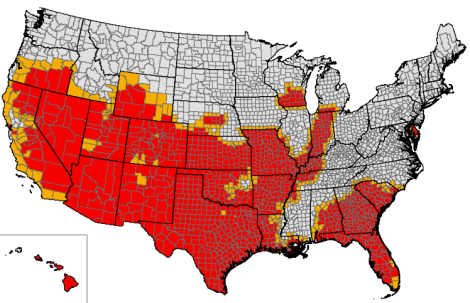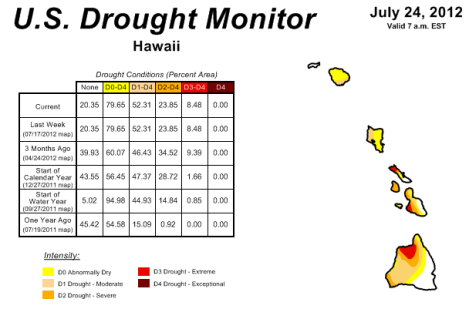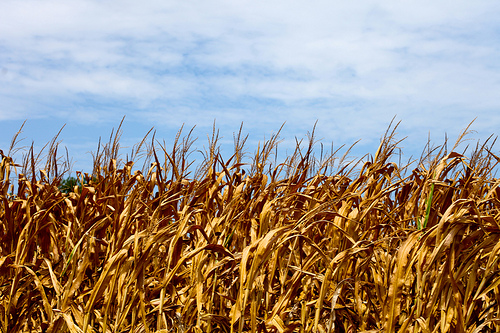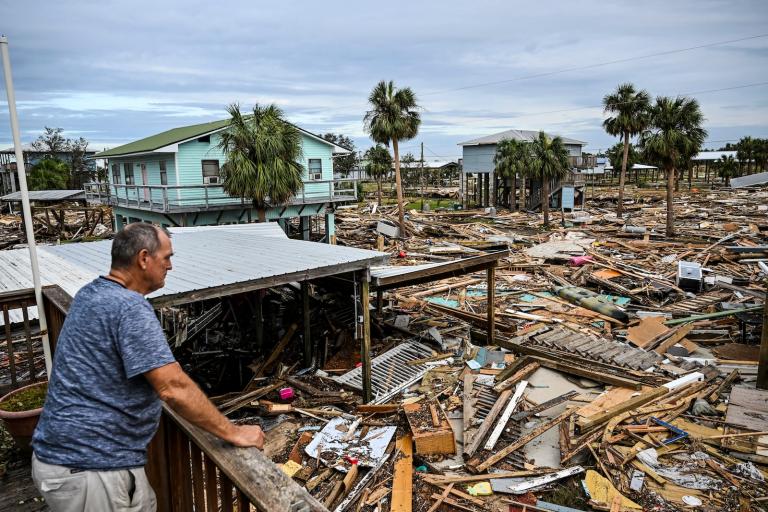This drought, man.
Yesterday, the U.S. Department of Agriculture (USDA) declared another 76 counties to be disaster areas as a result of the drought, bringing the total to 1,234. There are 3,033 counties in America. The map of declared disaster areas looks like this:

I mean, half of Hawaii is a disaster area.

Click to embiggen.
The drought is expected to lead to an increase in food prices (as we’ve noted previously). The New York Times has a big story on food prices this morning that’s worth a look. And here’s the USDA’s preliminary prediction for what food price increases to expect. The expected drop in corn availability has already pushed at least one U.S. meat producer to import corn from Brazil as a hedge against a shortage this fall.
We can also expect an increase in insects, hooray. From Southern California Public Radio:
“Insects are cold-blooded, which means that their body temperatures are regulated by the temperature of their environment,” said Missy Henriksen, the vice president of public affairs for the [National Pest Management Association]. “In cold weather, insects’ internal temperatures drop, causing them to slow down. But in warm weather, they become more active. Larvae grow at a faster rate, reproduction cycles speed up and they move faster.”
Which means perfect conditions for a host of pests including fleas, ticks, termites, mosquitoes, brown recluse and black widow spiders and scorpions to flourish in the coming weeks. What’s worse, the hot, dry temperatures will eventually drive those pests to seek out moisture and cool places to dwell — like homes.
I repeat: hooray.
And we can expect basically everything to break. Earlier this month, we noted that train tracks and airplane runways are melting in the extreme heat; earlier this week, we noted that drought threatens power production. Today, the Times catches up, noting that extreme weather will push more infrastructure beyond its intended limits:
“We’ve got the ‘storm of the century’ every year now,” said Bill Gausman, a senior vice president and a 38-year veteran at the Potomac Electric Power Company, which took eight days to recover from the June 29 “derecho” storm that raced from the Midwest to the Eastern Seaboard and knocked out power for 4.3 million people in 10 states and the District of Columbia.
In general, nobody in charge of anything made of steel and concrete can plan based on past trends, said Vicki Arroyo, who heads the Georgetown Climate Center at Georgetown University Law Center in Washington, a clearinghouse on climate-change adaptation strategies.
Highways, Mr. Scullion noted, are designed for the local climate, taking into account things like temperature and rainfall. “When you get outside of those things, man, all bets are off.” As weather patterns shift, he said, “we could have some very dramatic failures of highway systems.”
So, to recap:
- The drought continues to spread.
- Food will get more expensive.
- Our houses will be infested with bugs.
- Highways and power stations will fail.
This probably isn’t related, but Gchat and Twitter also went down today, so I’m just going to throw that into the mix.
Point being: Construction on the Thunderdome is to begin immediately in the Badlands of South Dakota. Let’s make sure the concrete we use can withstand extreme heat.



